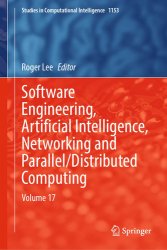Software Engineering, Artificial Intelligence, Networking and Parallel/Distributed Computing: Vol 17
- Добавил: literator
- Дата: 28-05-2024, 09:21
- Комментариев: 0
 Название: Software Engineering, Artificial Intelligence, Networking and Parallel/Distributed Computing: Vol 17
Название: Software Engineering, Artificial Intelligence, Networking and Parallel/Distributed Computing: Vol 17Автор: Roger Lee
Издательство: Springer
Серия: Studies in Computational Intelligence
Год: 2024
Страниц: 177
Язык: английский
Формат: pdf (true), epub
Размер: 35.4 MB
This book reports state-of-the-art results in Software Engineering, Artificial Intelligence, Networking and Parallel/Distributed Computing. This edited book.
presents original papers on both theory and practice. It addresses foundations, state-of-the-art problems and solutions, and crucial challenges.
Software error detection is a critical aspect of software development. However, due to the lack of time, budget, and workforce, testing applications can be challenging, and in some cases, bug reports may not make it to the final stage. Additionally, a lack of product domain knowledge can lead to misinterpretation of calculations, resulting in errors. To address these challenges, early bug prediction is necessary to develop error-free and efficient applications. In this study, the author proposed a system that uses Machine Learning to analyze system error logs and detect errors in real time. The proposed system leverages imbalanced data sets from live servers running applications developed using PHP and Codeigniter. The system uses classification algorithms to identify errors and suggests steps to overcome them, thus improving the software’s quality, reliability, and efficiency. Our approach addresses the challenges associated with large and complex software where it can be difficult to identify bugs in the early stages. By analyzing system logs, we demonstrate how Machine Learning classification algorithms can be used to detect errors and improve system performance. Our work contributes to a better understanding of how Machine Learning can be used in real-world applications and highlights the practical benefits of early bug prediction in software development.
The Git platforms, such as GitHub, are big data providers that store various development histories. Then, many researchers analyze data from such platforms from various aspects. Recently, AI-based systems have been used to construct themselves. However, there are no studies to measure the quality of the projects, and the ideal images of the projects need to be defined. This paper aims to find the ideal images of the projects in OSS (Open Source Software). For this, we extract the time-series project metrics from the famous OSS projects to categorize for detecting the patterns of projects’ growth. Our approach tries to explain the patterns and to give the decision for the patterns, good or not. The time-series metrics from projects include the number of stargazers, forks, commits, etc. The number of stargazers should increase as time passes, and the number of forks tends to decrease. The stargazer pattern indicates that many developers watch the repository since it was managed well. We conducted the case study to analyze the time series data from 10 repositories in GitHub. As a result, we found that the transitions of the number of issues typically form the sawtooth wave. The sawtooth wave pattern suggests that new issues are reported continuously and inventoried periodically. Therefore, the projects with the patterns indicate they are managing well, and many developers pay attention.
Скачать Software Engineering, Artificial Intelligence, Networking and Parallel/Distributed Computing: Vol 17
Внимание
Уважаемый посетитель, Вы зашли на сайт как незарегистрированный пользователь.
Мы рекомендуем Вам зарегистрироваться либо войти на сайт под своим именем.
Уважаемый посетитель, Вы зашли на сайт как незарегистрированный пользователь.
Мы рекомендуем Вам зарегистрироваться либо войти на сайт под своим именем.
Информация
Посетители, находящиеся в группе Гости, не могут оставлять комментарии к данной публикации.
Посетители, находящиеся в группе Гости, не могут оставлять комментарии к данной публикации.
